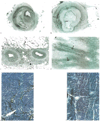Chronic rejection. A general overview of histopathology and pathophysiology with emphasis on liver, heart and intestinal allografts
- PMID: 9869851
- PMCID: PMC3235804
Chronic rejection. A general overview of histopathology and pathophysiology with emphasis on liver, heart and intestinal allografts
Figures





References
-
- Billingham ME. Pathology of graft vascular disease after heart and heart-lung transplantation and its relationship to obliterative bronchiolitis. [Review][17 refs] Transplant Proc. 1995;27(3):2013–2016. - PubMed
-
- Cramer DV. Cardiac Graft Atherosclerosis. In: Paul LC, Solez K, editors. Organ Transplantation: long-term results. New York, NY: Marcel Dekker; 1992. pp. 173–195.
-
- Balk AHMM, Weintar W. Chronic Heart Graft Rejection in the Clinical Setting. In: Paul LC, Solez K, editors. Organ Transplantation: long-term results. New York, NY: Marcel Dekker; 1992. pp. 187–195.
-
- Berry GJ, Rizeq MN, Weiss LM, Billingham ME. Graft coronary disease in pediatric heart and combined heart-lung transplant recipients: a study of fifteen cases. Journal of Heart & Lung Transplantation. 1993;12(6 Pt 2):S309–S319. - PubMed
-
- Radley-Smith RC, Burke M, Pomerance A, Yacoub MH. Graft vessell disease and obliterative bronchiolitis after heart/lung transplantation in children. Transplant Proceed. 1995;27:2017–2018. - PubMed
Publication types
MeSH terms
Grants and funding
LinkOut - more resources
Full Text Sources
Medical
